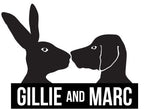Artists Studio - Town & Country
Getting to know art’s enfants terribles from their studio in Sydney, Australia
When artist duo Gillie and Marc Schattner entered their portrait of Olympic swimmer John Konrads into Australia’s Archibald Prize, the judging panel was confused. ‘Who’s Gillie Marc?’ they asked, bemused. It was 2006 and their first collaboration, a portrait of Konrads with the black dog of depression by his side when mental health was still a taboo subject. It was a first for the competition too, who consulted its board before accepting the work. ‘Because they recognised it,’ Marc explains over Zoom from the couple’s Sydney studio, ‘it gave us confidence, the credibility to say, “Let’s keep doing this thing”.’
Gillie and Marc met on a film shoot in Hong Kong in 1990 – ‘it was literally love at first sight,’ declares Gillie. ‘A week later we eloped to Nepal. At the foothills of the Himalayas, we got married.’ It sounds like a straightforward love story but in fact both had to break off engagements to their fiancés back home. ‘Everyone said it wouldn’t last, but we just had our 33rd wedding anniversary,’ declares Marc happily.
They have become known for their works that merge human bodies with animal heads, usually a dog and a rabbit. Their first sculpture ‘we made in fibreglass. It was a three-metre dog man, naked, on all fours,’ Gillie explains.
‘It was very polarising, and we realised sculpture has a lot of impact.’ Natural rebels, they don’t subscribe to the career trajectory that frames the lives of most artists. ‘Everything we do is: “if you can break a rule, let’s break it”,’ says Mark. While galleries worry about over-exposure, Gillie found this restrictive. ‘We wanted to work in multiple mediums, and create and exhibit all the time. We broke free and started our own gallery.’
It works in a similar way with their public art, a new exhibition of which is coming to London this September. They communicate with landowners and mayors, cover costs for production, installation and insurance, and fund the work with sales of smaller work and attracting sponsors. ‘Obviously you don’t want to go broke, but we want to spread messages, transform ideas. If it costs us everything that we’ve got, which it does, that’s our value,’ says Marc.
The positive feedback from the public has been a surprise – especially after the vast column inches dedicated globally to the opposite. ‘In the beginning it hurt. Critics were not just unkind but ruthless, made a point of going after us,’ says Marc. ‘But we’re huge admirers of Damien Hirst, and he’s got so many haters, he doesn’t care. Jeff Koons, same thing. America wants to pile on him. We’ve learnt a lot from these artists, they’re weathering the storm.’
They are also commissioned to create statues of Olympians, politicians and historic figures. After making 30 or 40, they realised with unease that all the works were of men. ‘We did a bit of research: the whole world had the same issue,’ says Gillie. ‘Only three percent of statues were female – insane.
So we set up Statues for Equality, to try to balance the gender gap.’ They launched near the Rockefeller Centre in New York with statues of ten women including Oprah Winfrey, Nicole Kidman and Jane Goodall. ‘Funding for the arts is pathetic, it really is,’ says Marc. ‘Sculptures are expensive and cities spend zero on it. If it’s important enough, we’ll have to do that ourselves.’
This is art for conservation and awareness but also for a sense of place, a shared outlook. Art should be for the passer-by, the toddler in their pram, children who thrive on humour and playfulness. It might not suit some critics, but art should be for everyone.
Public sculpture exhibition, A Wild Life for Wildlife, will be on display at London Bridge from 19 Sept 2023 to 18 Sept 2024. lovethelast.com


